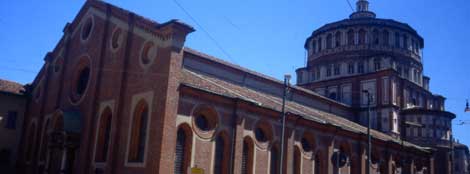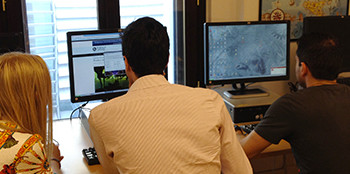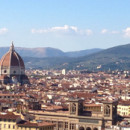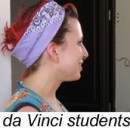If yes, then in Milan don't miss a visit to the old Dominican monastery of Santa Maria delle Grazie where in the refectory you can admire one of the greatest frescoes of all time: Leonardo's Last Supper illustrating Christ when he predicts that one among his apostles will betray him. The famous fresco is already the focus of mythical speculation after author Dan Brown based his fiction around the painting.
Leonardo was commissioned to execute the painting by Duke of Milan, Ludovico Sforza. He began painting in 1495 and completed it in 1498. Unfortunately, Leonardo tried a new technique here which has led to the deterioration of the painting in very short time. Christ's feet were cut off sometime by a doorway having been opened through the painting. The last restoration, completed in 1999, was more "repainting" rather than "restoring". Reservation to view the fresco is highly recommended, because the refectory building is so small, that only little group of tourists can go in every 15 minute. Photo taking is not allowed.
Let´s go a little bit further,
The Last Supper (Il Cenacolo or L'Ultima Cena) is a 15th century mural painting in Milan created by Leonardo da Vinci for his patron Duke Ludovico Sforza and his duchess Beatrice d'Este. It represents the scene of The Last Supper from the final days of Jesus as narrated in the Gospel of John 13:21, when Jesus announces that one of his Twelve Apostles would betray him. The Last Supper covers the back wall of the dining hall at the monastery of Santa Maria delle Grazie in Milan, Italy. This beginning date is not certain, as "the archives of the convent have been destroyed and our meager documents date from 1497 when the painting was nearly finished."
The painting contains several references to the number 3, which represents the Christian belief in the Holy Trinity. The Apostles are seated in groupings of three; there are three windows behind Jesus; and the shape of Jesus' figure resembles a triangle. There may have been other references that have since been lost as the painting deteriorated.
How it was done?
Leonardo da Vinci painted The Last Supper on a dry wall rather than on wet plaster, so it is not a true fresco. Because a fresco cannot be modified as the artist works, Leonardo instead chose to seal the stone wall with a layer of pitch, gesso and mastic, then paint onto the sealing layer with tempera. Because of the method used, the piece began to deteriorate a few years after Leonardo finished it. Two early copies of The Last Supper are known to exist, presumably the work of Leonardo's assistant. The copies are almost the size of the original, and have survived with a wealth of original detail still intact.
A first restoration was attempted in 1726 by Michelangelo Bellotti, who filled in missing sections with oil paint then varnished the whole mural. This repair did not last well and another restoration was attempted in 1770 by Giuseppe Mazza. In 1821 Stefano Barezzi, an expert in removing whole frescoes from their walls intact, was called in to remove the painting to a safer location; he badly damaged the centre section before realizing that Leonardo's work was not a fresco. Barezzi then attempted to reattach damaged sections with glue. From 1901 to 1908, Luigi Cavenaghi first completed a careful study of the structure of the painting, and then began cleaning it. In 1924 Oreste Silvestri did further cleaning, and stabilized some parts with stucco.
During World War II, on August 15, 1943, the refectory was struck by a bomb; protective sandbagging prevented the painting from being struck by bomb splinters, but it may have been damaged further by the vibration. From 1951 to 1954 another clean-and-stabilize restoration was undertaken by Mauro Pelliccioli.
Restorations
The painting's appearance in the late 1970s was badly deteriorated. From 1978 to 1999 Pinin Brambilla Barcilon guided a major restoration project which undertook to permanently stabilize the painting, and reverse the damage caused by dirt, pollution, and the misguided 18th and 19th century restoration attempts. The restoration took 21 years and on May 28, 1999 the painting was put back on display, although intending visitors are required to book ahead and can only stay for 15 minutes. When it was unveiled, considerable controversy was aroused by the dramatic changes in colors, tones, and even some facial shapes.
Rumors – Speculations
- One common rumor surrounding the painting is that the same model was used for both Jesus and Judas. There is no evidence that Leonardo used the same model for both figures and the story usually overestimates the time it took Leonardo to finish the mural.
- Some writers identify the person to Jesus' right not with the Apostle John (as is supposed by iconographical tradition and confirmed by art historians) but with Mary Magdalene. This theory was plays a central role in Dan Brown's novel The Da Vinci Code (2003). By the same token the Apostle Philip (third figure to the left of Jesus, and the only other beardless male) could possibly be another woman (Martha?).
- Furthermore, they point out that the body angles between Jesus and the Apostle John form the letter M, a reference to the Magdalene, and that she and Jesus are dressed in similar but oppositely colored clothes, a negative image of each other.
- They also mention a number of other signs: a mystery knife pointed at one of the characters, that Leonardo da Vinci himself is in the painting with his face pointing away from Jesus, and that Jesus is confronted by an admonishing hand to his right making “the John gesture,” an index finger pointing up.
The above points are often debated with the following counter-arguments:
- Leonardo was requested to paint the Last Supper, which naturally included Jesus and his Twelve Apostles. As there are only thirteen figures in the painting, an apostle would have been missing to make way for Mary Magdalene.
- The figure in question is presumably wearing male clothing, as he is wearing the same kind of garments as, for instance, Jesus.
- Other paintings from that period (Castagno's 1447 and Ghirlandaio's 1480) also show John to be a very boyish or feminine looking figure with long fair hair. This was because John was the youngest and most unquestioningly devoted of the apostles. Hence he is often shown asleep against Jesus’ shoulder.
Sabrina Sforza Galitzia, a Vatican researcher, claimed to have deciphered the "mathematical and astrological" puzzle in Leonardo's The Last Supper. She said that he foresaw the end of the world in a "universal flood" which would begin on March 21, 4006 and end on November 1 the same year. He believed that this would mark "a new start for humanity".
Why Leonardo´s Last Supper it´s so different?
Leonardo’s Last Supper breaks from tradition in several ways. One of the most obvious differences between Leonardo’s depiction of the Last Supper and the depictions of previous artists, such as Castagno and Ghirlandaio, is that Leonardo does not separate Judas from Christ and the other Apostles by seating him on the opposite side of the table.
Instead, Judas is identifiable because he is the only character who is slightly turned with his back to the table. As a result of Judas’s placement on the same side of the table as Christ and the obvious confusion felt by the Apostles, the viewer’s immediate response is to ask, “Am I betraying Christ” This reflects both Leonardo’s and Alberti’s belief that a good painting should move the viewer to express the same emotions as those felt by the figures within the painting.
However, the confusion felt by the Apostles and the viewer is contrasted by the apparent calmness of Christ. Christ is calm because he knows which apostle has betrayed him, reminding the viewer that Christ is God. In addition, the Apostles in Leonardo’s painting show more movement and interaction with each other in order to represent their emotional state.
Several of the Apostles point to Christ or themselves out of confusion. The Apostles are gathered into four groups of three, where they seem to say to each other, “It’s not I who has betrayed Christ, is it you?” As can be seen by the various looks of shock, confusion, distraught, etc., no two Apostles have the exact same response, which is a testament to Leonardo’s belief in naturalism. The gesticulations towards the center of the painting draws the viewers eyes upon Christ, where Christ is set apart, occupying space in the center. The confusion at the table leads the viewer to believe that Christ has not yet announced who has betrayed Him.
--
Yeniret Prokesch
Scuola Leonardo da Vinci Milan
Thanks to its prestigious universities and academies, Milan is the elected place of education for numerous Italian and international students.
Latest posts by Scuola Leonardo da Vinci Milan (see all)
- Milan on a Plate: Discovering the City Through Food - November 21, 2025
- 20 Years of Learning Italian in Milan! - October 20, 2025
- Watch and Learn: Movies Recommended by Italian Teachers - September 9, 2025









